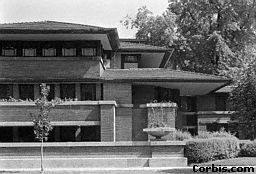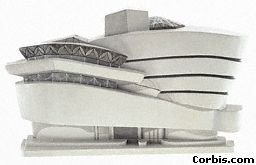
Frank Lloyd Wright
by Courtney McNeal
Frank Lloyd Wright was one of the most influential designers of modern architecture and design. He was born June 8, 1867, in Richland Center, Wisconsin. He studied at the University of Wisconsin in the field of engineering because courses in architecture were not available at the school. In 1887, Wright moved to Chicago were he became a draftsman for Joseph Lyman Silsbee, who was a famous Mid-western architect. While working for Silsbee, Wright designed his first building. Later in that same year, Wright became a designer at the firm of Alder and Sullivan. Wright soon became their chief draftsman. Louis Sullivan, one of the partners at the firm, had a profound influence upon Wright’s work. Wright was forced to leave the firm of Alder and Sullivan because of his "bootleg" homes. People were at first opposed to his new and different approach to architecture and design. In 1893, he began his own practice. Wright soon began to design and build houses of his own that reflected Louis Sullivan’s influence. Wright’s designs also revealed his independent talent and nature.

Wright’s Falling Water House
Wright's first distinctive buildings were his homes designed in his famous prairie style. In this style typically spaces inside the house open into the outdoors through porches and terraces. The characteristics of the prairie style homes often include open floor plans, low sweeping roof lines, and uninterrupted rows of windows. The interior space flows from a massive central brick or stone fireplace in an asymmetrical cross-axial plane without transition to the exterior and beyond. Wright believed that buildings’ surroundings and the function the building would serve should designate how the building was designed. Wright created a total environment within his homes, he required that all finished and furnishings be conceived as integral parts of the whole entire home. It is said that he would even dictate which flowers should be put in which vases and what clothing his clients should wear to be in complete harmony with the house.

The Robie house was one of
Wright’s more famous Prairie style homes.
In the 1920’s Wright’s began using precast concrete blocks reinforced by steel rods in his buildings. These blocks were first used in Wright’s Southern California creations of the later 1920’s. Wright also introduced air conditioning, indirect lighting, and panel heating. The Larkin Building in Buffalo, New York was the first office building to utilize air conditioning, double-panned glass windows, all-glass doors, and metal furniture. One of his most remarkable engineering feats was the design of the Imperial Hotel in Tokyo, which was constructed to withstand earthquakes. In this hotel he used cantilever construction with a foundation floating on a bed of soft mud. Not soon after the building was completed in 1922 an earthquake occurred, but thanks to the innovative technology the building suffered no damages. He also designed the innovative Guggenheim Museum, which was completed just before his death.

This is a model of the Guggenheim Museum
The interior of the Museum is dominated by a spiral ramp that runs from floor to near ceiling.

Arial view of section of the Guggenheim Museum
Wright also established the Taliesan Fellowship. This fellowship was made up of architectural students who paid to live and work with Wright. This school at Taliesan West in Arizona is still an active center for architectural students. Wright also spent much of his time writing, lecturing, and teaching. Many of his creations have not even been built yet.

This is the Marin County Civic Center
The Marin County Civic Center is a series of long structures that connects three hills. About nine buildings are eventually planned for the center, which is scheduled to be completed in 2000. It is located on the west side of Highway 101 in San Rafeal, California. You can’t miss it as you drive by on your way to San Francisco from Willits.
Frank Lloyd Wright died in Phoenix, Arizona, on April 9, 1959. He was 92 years old.
Encarta Encyclopedia 99 (CD-ROM) Microsoft, 1999
"Frank Lloyd Wright: Designs for an American Landscape, 1922-1932" @ http://lcweb.loc.gov/exhibits/flw/flw00.html - 5/4/2000
Roth, Leland M. "Wright Frank Lloyd" The World Book Encyclopedia, Vol. 24. Edition 1990.
Picture Credits:
Picture #1 - "Frank Lloyd Wright" from: www.corbis.com
Picture #2 - "Wright’s Falling Water House" from: www.corbis.com
Picture #3 - "Robie House" from: www.corbis.com
Picture #4 - "Guggenheim Museum in model" from: www.corbis.com
Picture #5 - "Arial view of section of the Guggenheim Museum" from: www.corbis.com
Picture #6 - "Marin County Civic Center" from: www.corbis.com